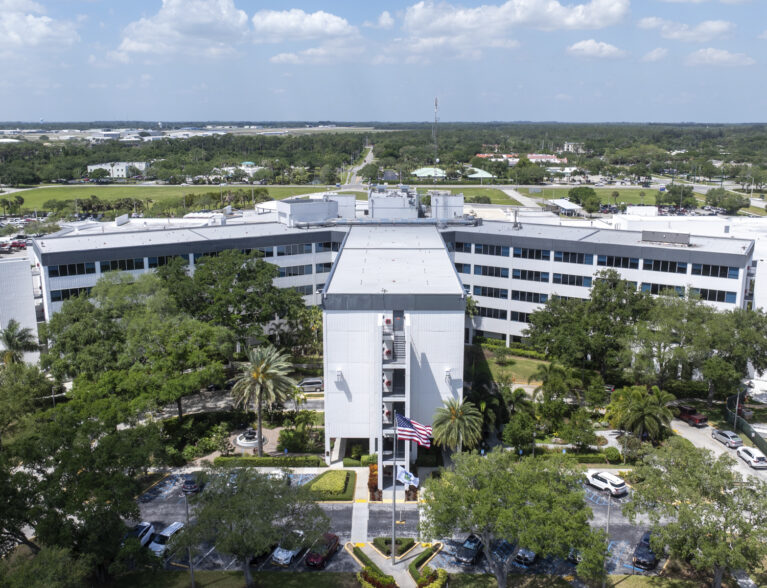
Cleveland Clinic Indian River Hospital celebrated National Donate Life Month in April with a gathering of hospital staffers, representatives from the Our Legacy donor program, and a special guest – Vero Beach resident and heart transplant recipient Paige Jerome.
“It was the first week of March 2019 and I wasn’t feeling well,” Jerome said. “We thought I had bronchitis going into pneumonia but because I was only 47 they didn’t really check. That night I collapsed in my kitchen and my son put on my shoes, called my mom and they rushed me to the Indian River Hospital emergency room.
“Dr. (Brett) Faulknier was called in. He had just joined the integrated heart care team with Weston hospital a few months earlier and he immediately contacted them. He diagnosed me with giant cell myocarditis and determined that I most likely needed a heart transplant. I later found out that if I hadn’t gone to the emergency room immediately, I would have died within 90 minutes.”
“Giant cell myocarditis is a diagnosis that requires quick action,” said Faulknier, DO, electrophysiologist at Cleveland Clinic Indian River Hospital, noting that he quickly arranged “for Paige to go to Cleveland Clinic Weston Hospital where her heart failure from this disease could get immediate attention and she could receive the treatment she needed. The advantage of being part of Cleveland Clinic is that we can make these resources immediately available to an acutely ill patient who needs prompt intervention to survive.”
Despite the quick initial action and transport to Cleveland Clinic Weston, Jerome was destined to die if she didn’t get a new heart within four days.
“I was moved to the top of the heart transplant waiting list because of the severity of my condition,” Jerome explained. “I couldn’t sustain life without a new heart and only had four days to live. I was intubated on Tuesday, and I got a new heart on Friday morning.”
The recovery was difficult. Jerome spent the first 40 days in the hospital and then went to an acute care rehab facility. Three months after she went home, she had a rejection and was back in the hospital for 26 days. She was home for four days then back to the hospital for another 11 days.
She spent a total of 81 days in the hospital over the first several months.
“I owe my life to my heart donor and the incredible team of doctors at Cleveland Clinic,” Jerome said. “I don’t know my donor’s name, but I know she was young, she was involved in animal rescue and her family called her their Georgia peach. I wear a peach and animal patches on my jean jacket as a tribute to her.”
Being a heart recipient not only saved her life; it also totally changed the direction of her life.
“I’m very involved in the Our Legacy donor organization in Orlando. They have five procurement agencies in the state, so I signed up as a volunteer at the west coast and south Florida agencies.
I’m always willing to talk to anyone about the donor program and how it saved my life.”
Jerome now works as a student program coordinator at Indian River State College. She is grateful to the dozens of hospital staffers in both hospitals who assisted in her care; to Dr. Faulknier, whose quick diagnosis and action gave her time to acquire a new heart; and to Dr. Cedric Sheffield, the cardiothoracic surgeon at Cleveland Clinic Weston Hospital who performed the heart transplant.
According to Donate Life America – a nonprofit organization that works to educate, inspire and activate individuals to become organ, eye and tissue donors – more than 170 million U.S. adults have registered their donation decision, but the need continues to outpace the availability of organs for transplantation.
Currently there are more than 103,000 men, women and children waiting for an organ transplant, including 5,000 in Florida. Sadly, about 20 people die each day while waiting for an organ transplant.
April has been designated National Donate Life Month to raise awareness of the increasing need for organ, tissue and eye donations, to encourage donation registration, and celebrate those who have saved lives through their organ donations.
There are two ways to donate. The first and easiest is to sign up to donate your organs upon your death. Each deceased organ donor can save up to eight lives, restore sight to two people and help to heal more than 75 people, according to the Health Resources and Services Administration at U.S. Department of Health and Human Services.
Identifying yourself as an organ donor while you are still alive takes the burden off your family to make that decision after your death.
The second type of donation is a living donation. Living donors can provide a kidney or a portion of their liver to a waiting patient. Eighty-six percent of patients waiting for an organ are in need of a kidney, and a healthy donor can live a fully functional, normal life with just one kidney.
Interestingly, the liver is the only organ that grows back and the donated portion of a liver regenerates in just four months.
If you haven’t registered on your driver license or state ID card and would like to, you can sign up to save lives at DonateLifeFlorida.org.



